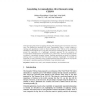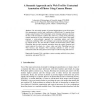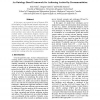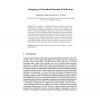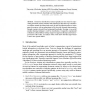ENTER
2007
Springer
14 years 5 months ago
2007
Springer
There has been great interest in applying Semantic Web technologies to the tourism sector ever since Tim Berners-Lee introduced his vision. Unfortunately, there is a major obstacl...
WISE
2007
Springer
14 years 5 months ago
2007
Springer
The increasing number of personal digital photos on the Web makes their management, retrieval and visualization a difficult task. To annotate these images using Semantic Web techno...
ICALT
2007
IEEE
14 years 5 months ago
2007
IEEE
In this paper, we propose the use of Semantic Web technologies to bridge the gap between authoring systems and authors. The core part of our solution is the ontology-based framewo...
ICALT
2007
IEEE
14 years 5 months ago
2007
IEEE
The vision of a common international education space includes a scenario for the composition of personalised study curricula consisting of modules offered by different universitie...
AH
2008
Springer
14 years 5 months ago
2008
Springer
Web browsing is a complex activity and in general, users are not guided during browsing. Our hypothesis is that by using Semantic Web technologies and personalization methods, brow...
SEMCO
2008
IEEE
14 years 5 months ago
2008
IEEE
The agent-based approach is an effective one for building middleware interconnecting distributed heterogeneous resources and providing semantic interoperability among them. On the...
ICALT
2008
IEEE
14 years 5 months ago
2008
IEEE
This paper discusses how Semantic Web technologies are being adopted, specialized, and put in practice in order to set up a technical infrastructure that will facilitate sharing a...
ESWS
2009
Springer
14 years 6 months ago
2009
Springer
Abstract. Semantic Web technologies such as RDF are usually incorporated in the infrastructure of desktop and web applications and can currently not be entirely deployed on mobile ...
IAT
2009
IEEE
14 years 6 months ago
2009
IEEE
In this paper, we present a new approach, called SATIS (Semantically AnnotaTed Intentions for Services), relying on semantic web technologies and models, to assist collaboration a...
KDD
2004
ACM
14 years 12 months ago
2004
ACM
Abstract. Current text classification systems typically use term stems for representing document content. Semantic Web technologies allow the usage of features on a higher semantic...
